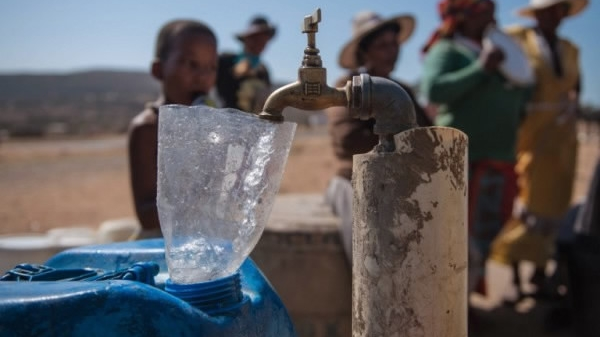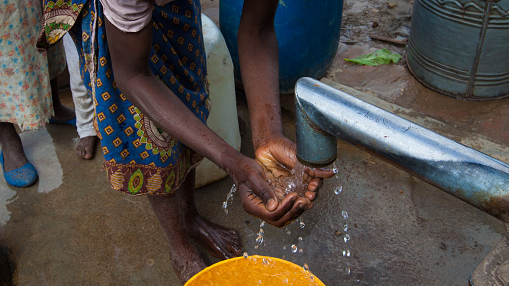
Editor's note: Alexander Ayertey Odonkor is an economic consultant, chartered financial analyst and a chartered economist with an in-depth understanding of the economic landscape of countries in Asia and Africa. The article reflects the author's opinions, and not necessarily the views of CGTN.
Data from the United Nations Environment Programme (UNEP) has shown that 25 out of the 55 countries on the African continent will record water levels below 1,700 cubic meters per capita per year by 2025, representing an acute water shortage in these countries. In Sub-Saharan Africa (SSA) where water crisis is prevalent, the region is home to about 50 percent of the world's entire population that do not have access to clean water.
In the last 25 years, the region's population has almost doubled, yet access to water has only improved by 20 percentage points within this duration. A survey conducted in 24 countries in SSA, suggests that more than two-thirds of the entire population in these countries cover long distances away from their homes to collect water.
All in all, close to 3.36 million children and 13.54 million adult females spend more than 30 minutes every day on a journey to collect water for households in these countries.
With residents of urban and rural communities spending an average of 25 minutes and 30 minutes, respectively, to collect water away from home; collectively, adult females and children in SSA spend 40 billion hours per year in collecting water. According to the United Nations Entity for Gender Equality and the Empowerment of Women (UN Women), the time adult females and children spend collecting water in a year is equivalent to a year of France's total workforce; clearly, indicating that women and children spend a lot of time travelling to fetch water for households.
Lack of safe water and the struggle to access water has been detrimental to the wellbeing of people in these African countries, specifically women and children as this condition exposes them to many health risks, encourages child labour which leads to children dropping out of school in the region.
Data from the United Nations Children's Fund (UNICEF) shows that 500 children die every day from lack of safe water in SSA. Lack of clean water has exposed the sanitation in the region to a host of water-related diseases such as diarrhea and cholera. Collectively, about 180,000 children under 5 years of age die every year as a result of diarrhea.
Meanwhile, Africa does not lack water resources. In fact, the African continent has 63 international transboundary river basins that cover about 64 percent of the region's land area and accounts for 93 percent of the total surface water on the continent. The abundance of water resources in Africa does not reflect the current water condition on the continent.
This unpleasant condition is partly attributed to the fact that water resources are poorly managed in Africa. As the population in Africa continues to grow, successive governments and relevant stakeholders have failed to meet the increasing water demand of the population, as they barely invest in water infrastructure to cater for the growing demand for water.
With the growing population heavily dependent on old water infrastructure to supply water to households, most of these dams and water supply networks are poorly maintained. This has led to some of these dams being underused as they currently supply a quantity of water below their original capacity.

A young girl washes her hands at a borehole. /Getty Images
A young girl washes her hands at a borehole. /Getty Images
This situation is prevailing in urban areas, as the growing level of the urban population in Africa has increased the demand of water. Unlike North Africa, which made an immense progress by extending water coverage to a large proportion of the population in the region under the Millennium Development Goals (MDGs), SSA's urban population growth has outpaced advances in water coverage among countries in the area.
With an urban population that is projected to reach 1.3 billion by 2050, currently only 56 percent of SSA's urban population has access to piped water, a decline from 67 percent in 2003.
For several decades, governments in Africa have failed to match the growing demand of water with adequate investments in water infrastructure as countries in Africa invest only 0.5 percent of their gross domestic product (GDP) and a small percentage of foreign assistance in the water sector which has an annual infrastructure investment gap of $22 billion.
This yawning infrastructure gap has been widened by weak water governance, which in most cases is largely influenced by poor management, below-cost recovery tariffs and low collection rates, particularly in countries with relative abundance of water resources.
Policy makers, development partners and relevant stakeholders have a significant role to play in improving water security in Africa. Adequate investments should be directed towards conducting top-notch water research at both regional and national levels as this will unearth the intricacies of the various factors that impede water coverage in the region.
This will also provide reliable data for the water sector that will aid policy makers in implementing evidence-based policies, which will promote efficient use of water resources in both urban and rural areas. Adequate data from research in the water sector will reveal the quantity of water that is wasted and the need to recycle this amount of water for other ideal purposes.
Through appropriate research in the water sector and other related sectors, governments and development partners could identify the size of investment that is required to scale-up the capacity of dams and water supply systems, which could improve access to clean water in Africa.
(If you want to contribute and have specific expertise, please contact us at opinions@cgtn.com.)